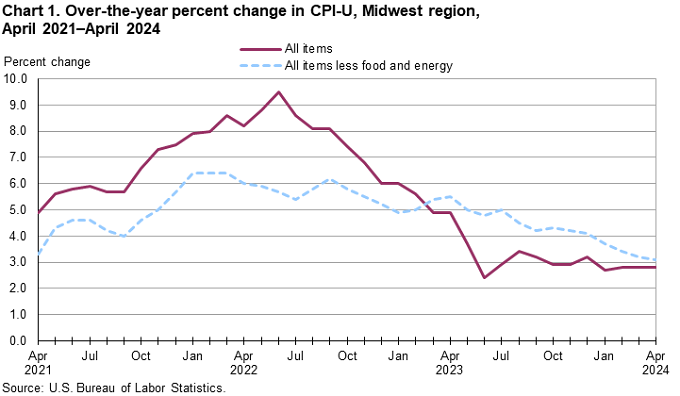KANSAS CITY – Prices in the Midwest Region, as measured by the Consumer Price Index for All Urban Consumers (CPI-U), advanced 0.5 percent in April, the U.S. Bureau of Labor Statistics reported today. The April increase was led by a 0.5-percent rise in the all items less food and energy index, with higher prices for shelter contributing most to the rise. The energy index was up 1.7%, while the food index rose 0.1%.
Over the last 12 months, the CPI-U increased 2.8 percent. The index for all items less food and energy rose 3.1 percent, and food prices advanced 2.0% over the year. The index for energy saw no change for the 12-months ending in April 2024. (See chart 1.)

Food
Food prices were unchanged for the month of March. Prices for food away from home (restaurant, cafeteria, and vending purchases) rose 0.1 percent, while prices for food at home (grocery store prices) fell by 0.1 percent for the same period.
Over the year, food prices rose 2.0 percent. Prices for food away from home increased 3.4 percent, and prices for food at home increased 1.2 percent since a year ago.
Energy
The energy index rose 3.6 percent over the month. The increase was almost entirely due to higher prices for gasoline (+8.9 percent). Prices for electricity were essentially unchanged, increasing 0.1 percent for the month. A decline for prices paid for natural gas service (-5.2 percent) partially offset these increases in March.
From March 2023 to March 2024, energy prices advanced 0.6 percent, largely due to higher prices for gasoline (+2.2 percent), but with electricity also contributing to the rise (+2.2 percent). Partially offsetting the rise in prices was a decline in natural gas service, which fell 8.4 percent over the year.
All items less food and energy
The index for all items less food and energy increased 0.5 percent in March. Higher prices for owners’ equivalent rent of residences (+0.6 percent), medical care services (+0.6 percent), and rent of primary residence (+0.7 percent) were the largest contributors.
Over the year, the index for all items less food and energy rose 3.2 percent. Components contributing to the increase included owners’ equivalent rent of residences (+6.4 percent), rent of primary residence (+6.4 percent), and other goods and services (+6.4 percent). Partly offsetting the increases were falling prices for household furnishings and operations (-3.1 percent) and lodging away from home.
